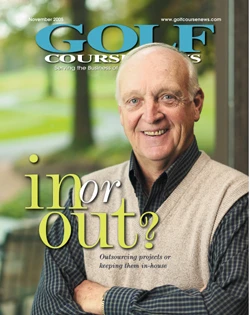Between mid-August and late September, four hurricanes – Charley, Frances, Ivan and Jeanne – pummeled Florida one right after the other in a procession of high-speed winds and torrential rains. Worst of all, Jeanne hit land in almost the exact same place as Frances, further punishing Palm Beach County as it tried to recover.
By the end of September, Floridians were counting down the days until Nov. 30, the official end of hurricane season, and many snowbirds were contemplating a move back north or at least to somewhere other than Hurricane Alley.
Experts have estimated that this year’s hurricane season will be the costliest on record, and news reports have surfaced about the difficulty some residents have had getting their insurance adjusters to arrive at their properties.
|
|
Because Florida is home to more golf courses than any other state, it should come as no surprise that this hurricane season created a number of problems – ranging from flooding to downed trees and worse – for the golf community, particularly those courses on the Atlantic coast that felt the impact of the Frances-Jeanne double whammy. Sebastian Municipal Golf Course, Diamondback Golf Club in Haines City, The Breakers at Palm Beach and the Punta Gorda Country Club are a few of the many courses that dealt (and are probably still dealing) with damage and financial loss as a result of the hurricanes.
A financial setback
For the most part, restoring a course to playability after the hurricanes involved moving trees and other debris off the course, according to Greg Gardner, general manager at Sebastian Municipal Golf Course.
“I’d say probably 90 percent of it was tree and debris cleanup,” Gardner says.
But aside from damage to the course, the rest – repairing damaged buildings, pump houses and irrigation systems – had to be put off for the time being, according to Gardner. Additionally, securing a contractor became almost impossible.
“The availability of contractors – with all the jobs that they have taken on – it’s just not going to happen overnight, unfortunately,” Gardner says. “We’ve got a lot of that to worry about.”
Among those worries were damage to on-course bathrooms, which were replaced temporarily with portables ones, the clubhouse restaurant and cart barn, and the near-complete destruction of Sebastian’s range netting system. Because the range is located between two holes and is only about 200-yards deep, there was a 50-foot-high net held up by poles all the way around it. The system survived Frances with minimal damage. Then came Jeanne.
“It was torn up a little bit after Frances, but Jeanne just took care of the rest of it,” Gardner says. “We had about 85 percent of our poles broken, and they didn’t just fall down. The way the wood was broken and shattered, it just looked like a bomb went off from inside the pole. It just shattered.”
In all, Gardner estimated the damage total to be about $250,000. Repairing the restaurant roof took precedence over everything else. And to make matters worse, the club’s fiscal year started Oct. 1, which means the storms not only caused physical damage at the course, but also wrecked two fiscal years, according to Gardner.
A helping hand
Hurricane Charley took out an estimated 1,000 trees at Diamondback Golf Club. The hurricane also “renovated” the clubhouse by moving the back patio to the front parking lot and the front awning to the 16th hole behind the clubhouse. Because of the sheer number of trees, Diamondback general manager Jeff Parsons says there’s no way the course will be clear of trees any time soon.
“We will never, ever get to where we can clean up all the trees that were in our wetlands or in the outer perimeters,” Parsons says. “It would take a crew of 10 alone, plus equipment, to get in and haul that stuff out. We’re not a big club, so we’re doing it kind of piecemeal, and with our own guys at different points. From the standpoint of getting everything off the course and done, it’ll take us a good year.”
|
|
In all, Parsons estimated the cost to clean up and repair all the damage at Diamondback to be about $250,000 in machine and labor costs.
Diamondback did get a helping hand from out of state. Randy Waldron, superintendent at the Golf Club of Georgia in Alpharetta, heard about golf courses sustaining hurricane damage in Florida and wanted to do something to help. So he contacted his old friend, ChampionsGate Country Club superintendent Bobby Ellis, to see what he could do to help. Ellis referred him to Parsons, and Waldron sent one of his assistants, Steve Sisson, and some equipment to Diamondback.
“Our guys just really wanted to do something,” Waldron says. “A lot of us [from the Country Club of Georgia] are from Florida, so I asked Bobby to find a mid-level course that maybe didn’t have a big budget that needed help.”
The club convinced a local supplier to donate a chain saw for Sisson to take with him, and the maintenance staff collected about $300 to pass along to Diamondback’s maintenance staff.
Parsons says the good-will gesture was greatly appreciated.
“When Steve got here, he just pitched in and literally did whatever it took,” he says. “He cut trees down for us, he hauled trees, and he topdressed greens for us as we were moving forward. It was something that didn’t need to be done. He didn’t have to help us out like that, and he really did a great job for us.”
Breakdown
At The Breakers in Palm Beach, the one-two combination of hurricanes Frances and Jeanne caused a major disruption at the resort, which was completely closed for several weeks. The resort’s Ocean Course was closed for 31 days, including several days spent preparing for the storms’ arrival, according to Mark Reid, superintendent at The Breakers.
The Ocean Course suffered a huge landscaping blow because many trees not only were blown over, but they snapped in multiple places. The bunkers were severely washed out and contaminated with soil from the subgrade, and the course was underwater for a period of time, and that was before the second storm hit.
“The Ocean Course opened after the second storm in as good, if not better shape than before the storms,” Reid says. “The only thing different is the landscaping buffers, but we are working on the relandscaping.”
The two hurricanes also caused a bit of a setback at The Breakers’ West Course, which currently is in the late stages of a complete reconstruction designed by Rees Jones. But the damage could have been worse, Reid says.
A majority the trees that had been planted – about 300 – were blown over, but most of them were salvageable. But the biggest problem came from the turf. Prior to the first storm, the grassing was complete on everything but the practice facility, but the mix-out of all the greens that weren’t established well blew off and left voids on many greens.
“We didn’t lose any of the contours, and we were able to re-establish those with heavy topdressing by hand,” Reid says.
The bunkers, however, didn’t fare so well. They were all washed out quite badly, and some of the faces collapsed. Flooding also was an issue on the course.
“It took a week after both the storms for the water to recede to its set elevation in all the lakes,” Reid says. “The storms set us back on our opening a few weeks.”
The new opening is scheduled for Dec. 17.
A deal on hold
Considering all of the devastation, perhaps the saddest story of a hurricane-damaged golf course is that of the Donald Ross-designed Punta Gorda Country Club. Charley’s winds damaged or downed about 900 trees, and almost all the structures at the club suffered some sort of damage, including a cinder-block halfway house. Superintendent Brad Wright suspects a tornado was responsible for the majority of the structural damage, although he can’t confirm that.
As an added twist, last year, Punta Gorda’s membership had entered into an agreement with Trimerica Mortgage Co. to sell the club in exchange for nearby Port Charlotte Golf Club. Punta Gorda members have been leasing Port Charlotte in anticipation of the deal’s closing, which was slated for spring 2005.
Because Punta Gorda members have been operating two courses and have had their own losses to deal with, they decided to focus on repairing Port Charlotte, which reopened in September. They haven’t decided whether to rebuild Punta Gorda or not, and there’s no guarantee the Trimerica deal will still go through.
Bouncing back
There’s good news on the golf front though. Parsons says business at Diamondback is steady, and Gardner reported the same from Sebastian.
“A lot of people are dying to play golf, even though they’ve got a lot to do at home,” Gardner says. “They’re working a lot of extra hours, but they still want to try to get away and put it all out of their mind for a while.”
And as a reminder of the capriciousness of Florida weather, even when there’s no hurricane bearing down on the state, Sebastian’s reopening after two weeks was delayed by a day, leaving Gardner to ask the question that has most likely been asked thousands of times throughout Florida since August: “Is Mother Nature mad at us?” GCN
Derek Rice is a freelance writer from Portland, Maine, and can be reached at derekrice@maine.rr.com.

Explore the November 2004 Issue
Check out more from this issue and find your next story to read.
Latest from Golf Course Industry
- From the publisher’s pen: Foggy intrigue
- USGA releases Water Conservation Playbook
- Vilamoura Golf courses awarded GEO Certified status
- GCSAA’s Health in Action 5K/2K reaches fundraising goal
- Landscapes Golf Management to participate in data analyzation initiative
- Reel Turf Techs: Carl Michael
- Atlanta Athletic Club approves funding for master plan
- Maximizing Cultural Practices and Agronomic Benefits with Minimal Surface Disruption







